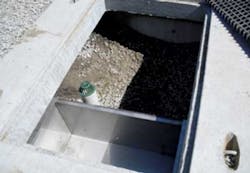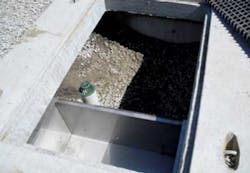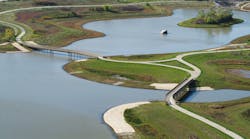By Gina Carolan
For decades, traditional development and stormwater management approaches have aimed to quickly remove runoff from the site. However, the low impact development (LID) movement has been changing this scenario, focusing attention on the environmental and fiscal benefits of managing runoff and associated pollutants at the source, preventing or reducing the impact of developments on local watersheds.
With LID, the goal of stormwater management becomes retaining runoff to maintain the pre-development hydrologic balance on a new construction or redevelopment site. Following the same basic principles as nature of managing rainfall, LID stormwater management practices infiltrate, filter, store, evaporate and detain runoff close to its source. Bioretention, reduced impervious areas, permeable pavement, vegetated landscaping, wetlands and green roofs are among these advanced stormwater practices.
Another stormwater management strategy that closely follows LID principles is subsurface infiltration and, specifically, an infiltrative chamber system. These systems can hold large volumes of runoff in the open-bottom chamber units and surrounding stone. The runoff then percolates through a filter fabric surrounding the chambers into the ground.
Pollutant Removal Is Key
Infiltration is a method naturally occurring on undeveloped land, and, whenever possible, is the preferred method of stormwater control for LID sites. Underground chamber systems, especially when used together with filtration technologies, remove a high percentage of suspended solids and organic compounds from runoff through infiltration, preventing or reducing pollution of the receiving waters. Reduction in both the volume of runoff and pollutant loads can improve habitat for aquatic and terrestrial wildlife and enhance recreational uses.
As pollutants vary from site to site, industry professionals can customize and combine LID strategies to reduce specific pollutants. An integrated stormwater management system using a variety of physical, chemical and biological processes to protect our water resources would produce the optimal results.
Counting Benefits
Taking into consideration growing water shortages nationwide, LID practices can also be employed to infiltrate runoff with the purpose of recharging groundwater. Infiltrative chamber systems offer significant groundwater recharge in areas with a high percentage of impervious surfaces. They allow for more controlled infiltration, replenish the surrounding soil and aquifer and increase stream baseflow.
Many areas, especially with aging infrastructure, have issues with combined sewer systems’ overflows (CSOs), which discharge sanitary wastewater during storm events. By retaining and infiltrating runoff back into the ground, subsurface infiltrative systems also reduce the frequency and amount of CSOs.
While some sites do not allow for infiltration, underground chamber systems can be employed together with rainwater harvesting practices to detain runoff and use it for a variety of onsite non-potable water needs, offering potential cost-savings to the property owner. One example is the use of an impervious liner under an underground chamber bed, from which the water is pumped to a storage tank.
Whether an underground chamber system is used for infiltration or detention, managing run-off at its original location rather than conveying it off-site or to a river or stream allows the site to remain as close to its original state as possible. It also helps avoid potential flooding of neighboring watercourses.
Easy to Use, Maintain
Chamber system manufacturers have responded to LID trends by introducing products to accommodate the various demands of LID sites. Engineers who are looking for maximum storage capacity but have a limited amount of land for a stormwater system can select large-size chamber units, which also offer the most cost-effective installation. By providing an ample subsurface storage void, industry professionals are able to closely manage pre- and post-construction storm events without affecting adjacent properties.
Development sites that present challenges in terms of high or varied water table elevations can still employ underground systems due to the extensive range of chamber sizes available to fit almost any site parameter. Installation of these systems can be done in one or several beds throughout the site, allowing engineers to accommodate building structures, preserve trees and other natural landscape features, thus reducing the amount of land disturbance required during construction.
Proper maintenance of runoff control practices is part of any good LID strategy. Subsurface chamber systems require a combination of pretreatment measures. For example, a catch basin and sump to keep impurities and debris from entering the storage area. Maintenance is minimal, required only of the preliminary collection system prior to feeding the bed or other filtering devices that may be used.
Money Matters
From the fiscal perspective, LID designs can be more cost-effective than traditional stormwater practices. While some individual LID methods can be more expensive as compared to traditional ones, cost-savings for LID projects are often realized on an overall project cost basis.
Significant cost-efficiency can result from the reduction of flood-control structures, including costs for site grading and preparation and drainage infrastructure. Underground chamber systems can serve as replacements for ponds, concrete structures or pipe and stone installations, saving cities and private developments on miles of costly pipes and acres of stormwater ponds. The use of other stormwater management related elements, such as gutters, curbs, catch basins, pipes and outlet control structures can also be reduced, lowering overall project costs.
Additionally, LID stormwater practices often result in less land disturbance and increased space for development. Underground chamber systems, for example, allow for the maximum use of land, leaving space for additional buildings, parking and landscaping, which is especially important in urban areas where land is at a premium. More space devoted to greenery contributes to a development’s enhanced livability, value and aesthetics, which increase the site’s property values and marketability.
While challenging to quantify, potential cost-savings associated with pollution prevention achieved due to LID methods should be noted. It is almost always less expensive to keep water clean than it is to treat it.
About the Author: Gina Carolan has worked for CULTEC, Inc. for 25 years and currently serves as C.O.O. and Director of Marketing for the company.
More WaterWorld Current Issue Articles
More WaterWorld Archives Issue Articles




